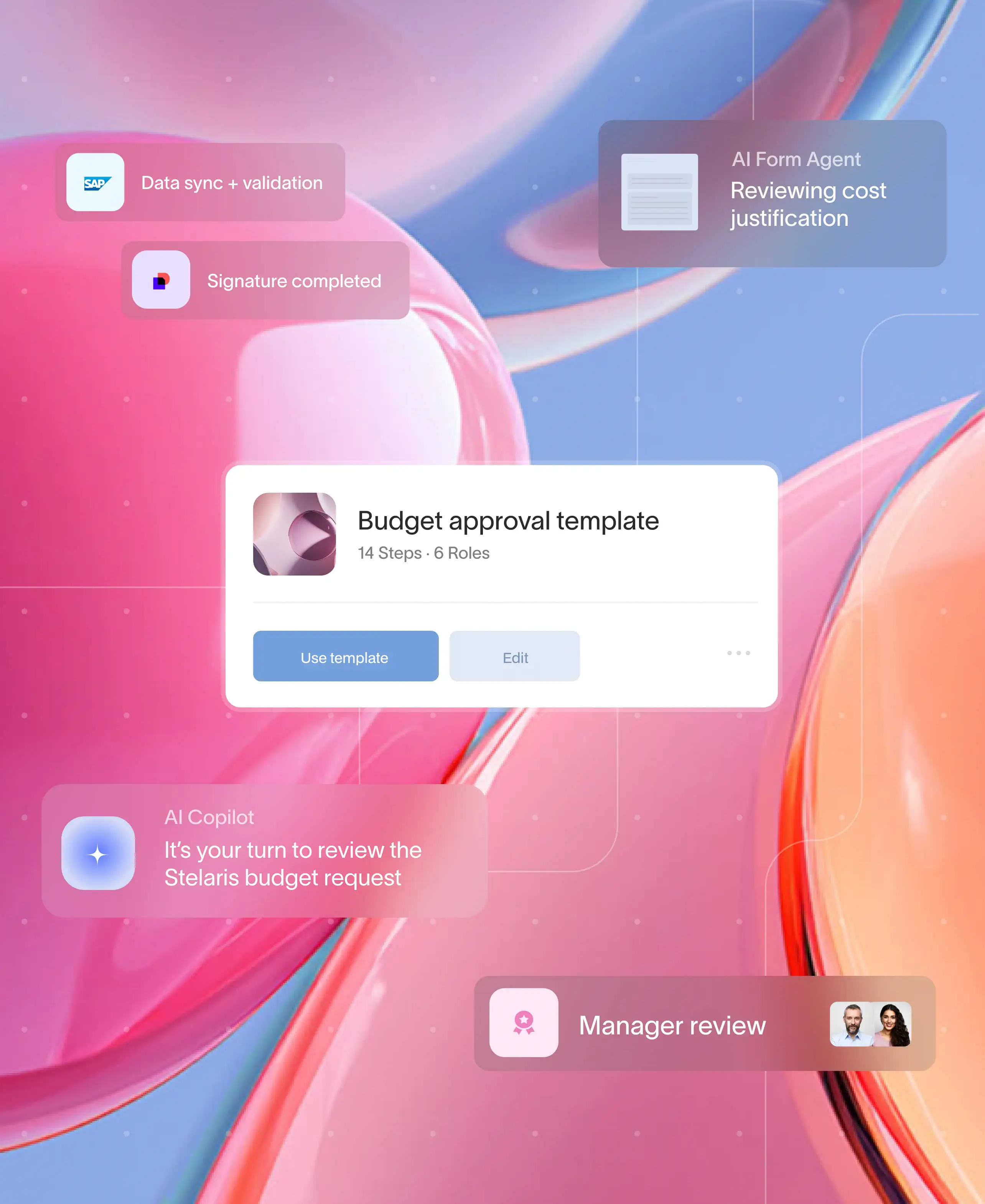
Efficient vendor onboarding is essential for organizations that want to maintain smooth operations, avoid compliance risks, and ensure strong partnerships. An organized vendor onboarding process ensures that new vendors meet all the necessary requirements, reducing delays and streamlining the supply chain. By using a vendor onboarding checklist, you can guarantee that every step is completed systematically, ensuring a consistent and professional approach.
What is a vendor onboarding checklist
A vendor onboarding checklist is a standardized tool used to ensure that all necessary tasks are completed when bringing a new vendor into your business. It provides a comprehensive guide to onboarding new vendors by laying out all the critical steps, from initial documentation to compliance checks. This process ensures smooth integration into your company's workflow, enhancing collaboration and operational efficiency.
Why is a vendor onboarding checklist useful
Having a detailed vendor onboarding checklist helps streamline the process by:
- Ensuring all legal and compliance standards are met
- Reducing delays caused by missing documentation or unclear communication
- Creating transparency between your organization and the vendor
- Building stronger vendor relationships by clarifying expectations from the start
Key items to include in your vendor onboarding checklist
An effective vendor onboarding checklist should cover several key areas to ensure smooth integration. Below is a list of items to include in a vendor onboarding checklist:
- Initial vendor screening and qualification
- Collection of the necessary documentation
- Compliance checks
- Vendor setup in internal systems
- Training and onboarding materials
- Performance monitoring and review criteria
- Risk management and contingency plans
- Ongoing communication plans
1. Initial vendor screening and qualification
Before onboarding a new vendor, it's critical to confirm that they meet your specific requirements and can reliably support your business operations. This phase ensures that your vendor is capable of delivering consistent results while adhering to your company’s standards. Possible aspects of vendor screening and qualification include:
- Financial stability – Ensuring the vendor has a strong financial foundation to avoid service interruptions.
- Previous performance history – Review the vendor’s track record to gauge reliability and quality of services.
- Capacity to meet demand – Verifying that the vendor can handle your company’s operational requirements without overextension.
- Industry reputation – Checking for positive industry feedback and references from past clients.
- Certifications and licenses – Ensuring the vendor holds any required certifications and meets regulatory standards.
2. Collection of necessary documentation
Gather all essential documentation from the vendor to establish a formal relationship and ensure compliance with your company policies. This step protects both parties and provides clarity in legal and operational terms. Documents to collect typically include:
- Signed contracts and agreements
- Tax forms (e.g., W-9)
- Insurance documents
- Confidentiality agreements (NDAs)
- Industry-specific certifications
3. Compliance checks
Ensure the vendor complies with all legal, regulatory, and industry standards that apply to your business. Compliance checks safeguard your organization from potential liabilities, such as data breaches or ethical violations. Areas to check include:
- Data privacy regulations (e.g., GDPR, CCPA)
- Cybersecurity standards
- Ethical sourcing and labor practices
- Environmental compliance, if applicable
4. Vendor setup in internal systems
To enable seamless transactions, vendors should be properly integrated into your internal systems. This includes creating profiles in your vendor management software and client portal. Key actions during vendor setup include:
- Adding vendor details to procurement and finance systems
- Configuring payment processes and terms
- Assigning points of contact within your organization
5. Training and onboarding materials
Providing thorough onboarding materials is essential to ensuring that vendors understand your processes and expectations. Clear training on software, communication protocols, and performance standards helps vendors integrate smoothly. Necessary training materials include:
- Guides on your internal systems or software platforms
- Company policies and procedures
- Workflow expectations
- Performance and quality standards
6. Performance monitoring and review criteria
Set up a framework to monitor vendor performance, ensuring that services are delivered as expected. This helps maintain accountability and ensures a high standard of service throughout the relationship. Typical performance metrics to track include:
- Delivery timelines
- Quality of goods or services
- Adherence to contract terms
- Responsiveness and communication quality
7. Risk management and contingency plans
Identify potential risks involved with vendor relationships and establish contingency plans to mitigate disruptions. Proper risk management ensures that your business can continue operating smoothly even if a vendor experiences issues. Steps to include:
- Identifying risks such as supply chain disruptions or financial instability
- Establishing backup vendors or alternate solutions
- Creating response plans for common risk scenarios
8. Ongoing communication plan
To foster transparency and trust, implement a structured communication plan with regular check-ins and updates. This ensures that both your organization and the vendor stay aligned, avoiding miscommunication and delays. Elements of a communication plan include:
- Scheduled status meetings or calls
- Clear escalation paths for urgent issues
- Regular performance reviews and feedback sessions
The importance of an efficient vendor onboarding process
An efficient vendor onboarding process checklist is vital for the long-term success of vendor relationships. By ensuring that each step is clearly defined and thoroughly executed, businesses can avoid delays, ensure compliance, and build stronger partnerships. A well-executed onboarding process also reduces the likelihood of future misunderstandings or service disruptions, ultimately contributing to a more efficient supply chain and smoother business operations. When businesses invest in a structured onboarding process, they can focus more on achieving results rather than resolving onboarding issues.
How Moxo can improve your vendor onboarding process
Moxo’s collaborative platform offers a comprehensive solution for streamlining vendor onboarding. With Moxo, businesses can automate document collection, compliance checks, and vendor setup while centralizing communication in one seamless workflow. Here’s how Moxo enhances your vendor onboarding process:
- Automated workflows eliminate repetitive tasks like documentation and compliance tracking.
- Centralized communication ensures that vendors and internal teams stay aligned throughout the onboarding process.
- Secure document sharing provides a safe space for exchanging sensitive contracts, certifications, and compliance paperwork.
- Integrated tracking and performance monitoring allows for real-time insights into vendor performance, enabling timely adjustments.
Conclusion
A well-structured vendor onboarding process is critical for maintaining efficient business operations and establishing long-term vendor partnerships. Using a vendor onboarding checklist ensures that every critical step is completed, minimizing risks and streamlining the workflow. With Moxo, businesses can further enhance their onboarding process by automating tasks, securing document exchanges, and maintaining clear communication with vendors.
Visit Moxo to get started.
FAQs
What is the vendor onboarding process?
The vendor onboarding process involves the steps needed to integrate a new vendor into a company's system, including qualification, compliance checks, and training.
How can a vendor onboarding checklist help my business?
A new vendor onboarding checklist ensures that every important task is completed in the onboarding process, reducing risks and enhancing efficiency.
How can Moxo improve vendor onboarding?
Moxo offers automated workflows, centralized communication, and secure document management, streamlining the entire onboarding process for businesses.





